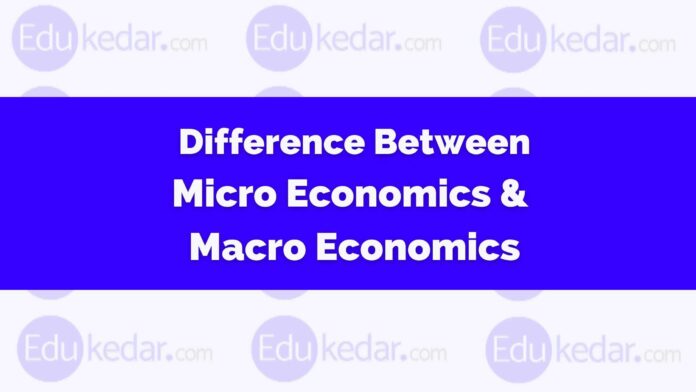Microeconomics deals with the behavior of individual economic units, while macroeconomics deals with the behavior of the economy as a whole. Here we have shared the difference between Micro and Macro Economics.
What are Micro and Macro Economics?
Microeconomics and macroeconomics are two branches of economics that focus on different aspects of the economy.
Microeconomics is concerned with the behavior of individual economic agents such as households, consumers, firms, and industries. It studies how they make decisions and interact in various markets to determine prices and quantities of goods and services exchanged. Microeconomics also analyzes the effects of government policies, such as taxes and regulations, on individual economic units.
On the other hand, macroeconomics focuses on the economy as a whole, rather than on individual agents. It studies the performance and behavior of the economy as a whole, including topics such as economic growth, inflation, unemployment, and international trade. Macroeconomics also analyzes the impact of government policies on the overall economy, such as monetary and fiscal policies.
Microeconomics
- Microeconomics studies individuals and business decisions, while macroeconomics analyzes the decisions made by countries and governments.
- Microeconomics focuses on supply and demand, and other forces that determine price levels, making it a bottom-up approach.
Macroeconomics
- Macroeconomics takes a top-down approach and looks at the economy as a whole, trying to determine its course and nature.
- Investors can use microeconomics in their investment decisions, while macroeconomics is an analytical tool mainly used to craft economic and fiscal policy.
Difference between Micro and Macro Economics
The main difference between Microeconomics and Macroeconomics are as under:
MICRO-ECONOMICS | MACRO-ECONOMICS |
|
|
| 2. It deals with Individual Income, Individual prices, Individual output, etc. | 2. It deals with aggregates like National Income, general price level, national output, etc. |
| 3. Its central problem is price determination and allocation of resources. | 3. Its central problem is the determination of the level of income and employment. |
| 4. Its main tools are the demand and supply of a particular commodity/factor. | 4. Its main tools are aggregate demand and aggregate supply of the economy as a whole. |
| 5. It helps to solve the central problem of ‘what, how, and for whom’ to produce in the economy. | 5. It helps to solve the central problem of the full employment of resources in the economy. |
| 6. It discusses how the equilibrium of a consumer, a producer, or an Industry attains. | 6. It concerns the determination of the equilibrium level of income and employment in the economy. |
| 7. Takes a Bottom-up approach to analyze any economy. | 7. Takes a Top-down approach to analyzing any economy |
| 8. It deals with households’ and firms’ decisions. | 8. It deals with aggregate decisions in the economy. |
| 9. Maximizing an individual’s welfare by saving more and spending less. | 9. Promote aggregate demand and investments in an economy |
10. Examples of Microeconomics factors:
| 10. Examples of Macroeconomics factors:
|
Also Read: Fundamentals of Economics
Also Read: Difference between Marketing & Selling
Also Read: Difference between Training & Development





